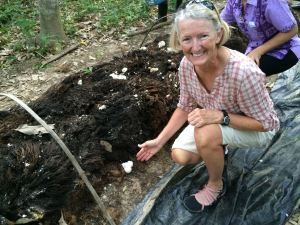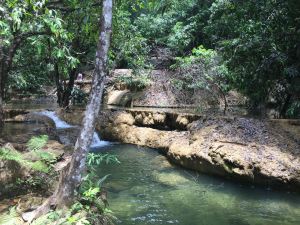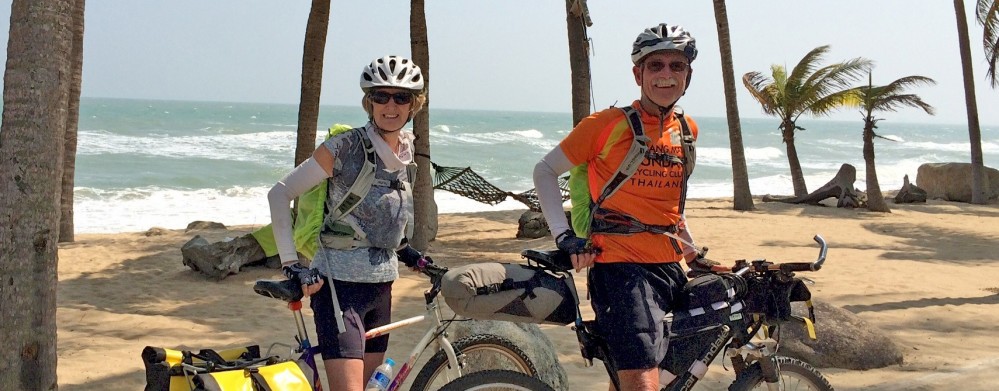 Quite a mixture of experiences this last weekend, which is fitting because it was our last full weekend in Trang. Next weekend we’ll be heading to Bangkok on Sunday in preparation for departure to Durango on Tuesday. Ever since we got waylaid in 2011, heading north when local flooding stopped our train in it’s tracks, we now stage our departure at least a day early to Bangkok. This year the flooding is in Bangkok, so you never can never tell.
Quite a mixture of experiences this last weekend, which is fitting because it was our last full weekend in Trang. Next weekend we’ll be heading to Bangkok on Sunday in preparation for departure to Durango on Tuesday. Ever since we got waylaid in 2011, heading north when local flooding stopped our train in it’s tracks, we now stage our departure at least a day early to Bangkok. This year the flooding is in Bangkok, so you never can never tell.
One last bike camping trip was on the agenda for this last Sunday, while Stanna took a trip south to our friend Chalong’s family gathering. I’d accompanied the Cycling Club to marshal in the Sai Rung Waterfall Fun Run in years past, but this one was more special as more than a hundred Trang cyclists came over early Sunday morning to join us at the event.
 What those cyclists missed on Saturday was hiking up the famous Sai Rung Waterfall (or infamous if you want to mention the historic flash flood there that killed 38 in 2007). All-granite cascades of falls and ponds roll down (or up in our case) hundreds of meters providing vistas, ponds, slides, pools for swimming and slick rock scrambling. Mists from the falls shine with rainbows giving it the name “Rainbow Waterfall”.
What those cyclists missed on Saturday was hiking up the famous Sai Rung Waterfall (or infamous if you want to mention the historic flash flood there that killed 38 in 2007). All-granite cascades of falls and ponds roll down (or up in our case) hundreds of meters providing vistas, ponds, slides, pools for swimming and slick rock scrambling. Mists from the falls shine with rainbows giving it the name “Rainbow Waterfall”.
 One of the best experiences was standing chest deep under a pounding falls that kneaded your shoulders and neck. Once again my Thai friends that don’t swim had their 4-one-liter-bottle-belts serving as PFD’s. I towed one cyclist across the pond to the falls so he might enjoy the massage too. Frolicking in waterfall ponds is an often sought destination for our Sunday weekend tours, and there are quite a number to choose from in the vicinity of Trang.
One of the best experiences was standing chest deep under a pounding falls that kneaded your shoulders and neck. Once again my Thai friends that don’t swim had their 4-one-liter-bottle-belts serving as PFD’s. I towed one cyclist across the pond to the falls so he might enjoy the massage too. Frolicking in waterfall ponds is an often sought destination for our Sunday weekend tours, and there are quite a number to choose from in the vicinity of Trang.
In the meantime, Stanna (also unaware of just what her “field trip” was about) went with Dr. Chalong (she just last week defended her dissertation in English – she is the Thai lady who visited us in Durango last summer), to attend her uncle’s wake. Evidently the Muslims hold a wake or memorial 40 days after the death and all acquaintances are invited to stop by. Giant caldrons of food are prepared and served to the guests in respect for the deceased.
The only other similar celebration we’ve attended was one for a past prime minister’s mother here in Trang in 2012, and that was attended by thousands, with bus-loads of “respect-payers” coming from all over the southern peninsula. This one was smaller by comparison, but even in this tiny village drew several hundred. We see these events every day in Thailand, where a large tent is set up adjacent to a house, generally taking up one lane of the roadway, with tables and chairs for the attendees but we rarely get invited to attend. Depending on the religion you might see the elaborate flower-decked refrigerated coffin in situ in the carport. Muslim passed are buried within 24 hours.
 All these southern Thai communities have a mix of palm oil or rubber tree “water” as their source of income, and until rubber water dropped to a sixth of it’s price.just recently all land owners have been quite prosperous. Chalong’s family has
All these southern Thai communities have a mix of palm oil or rubber tree “water” as their source of income, and until rubber water dropped to a sixth of it’s price.just recently all land owners have been quite prosperous. Chalong’s family has  added a bonus to their rubber tree groves by raising mushrooms in rows between the trees. The mushrooms can be picked daily.
added a bonus to their rubber tree groves by raising mushrooms in rows between the trees. The mushrooms can be picked daily.
 After the 5, 10 and 20K Fun Run the entire cycling contingent rode 30 km to a rural school to present donations of school supplies and sports equipment given by the Trang Tourism Board, banks, other schools and various cycling groups. Thai’s are prolific in their presentations with speeches and recognition of everyone and their sisters. Even I got to “present” a gift (twice) to students who dutifully paraded up for photos with the donors.
After the 5, 10 and 20K Fun Run the entire cycling contingent rode 30 km to a rural school to present donations of school supplies and sports equipment given by the Trang Tourism Board, banks, other schools and various cycling groups. Thai’s are prolific in their presentations with speeches and recognition of everyone and their sisters. Even I got to “present” a gift (twice) to students who dutifully paraded up for photos with the donors.
The finale of the day was cycling to a nearby waterfall that is not on any paved or dirt road. 40 or 50 of us followed several guides up rivulets of swampy jungle streams until we came to travertine dams and pools which got grander in scale the farther we pushed up the mountain. This was veritable jungle with
 mangrove sized roots blanketing the ground creating fallen leaf covered hidden puddles of muddy water. Tarzan-like vines hung down everywhere you passed and if it wasn’t uphill you could swing forward as a navigational aid. The only solid footing, besides a dry tree root, was the limestone edge of the travertine walls.
mangrove sized roots blanketing the ground creating fallen leaf covered hidden puddles of muddy water. Tarzan-like vines hung down everywhere you passed and if it wasn’t uphill you could swing forward as a navigational aid. The only solid footing, besides a dry tree root, was the limestone edge of the travertine walls.  My cleated Keens made secure footing problematic, but far better than for those in regular bike shoes. Half-way into this mire, many of us realized it was time to wrap-up our cameras and phones in case of inadvertent dunking caused by a slip or fall. As a consequence not many photos document the travertine traverse up the mountain.
My cleated Keens made secure footing problematic, but far better than for those in regular bike shoes. Half-way into this mire, many of us realized it was time to wrap-up our cameras and phones in case of inadvertent dunking caused by a slip or fall. As a consequence not many photos document the travertine traverse up the mountain.








 leaves, sliced red chilies and chicken. This was more of a soup boiling in the wok and we couldn’t imagine what would happen to turn this into a succulent sauce with chicken.
leaves, sliced red chilies and chicken. This was more of a soup boiling in the wok and we couldn’t imagine what would happen to turn this into a succulent sauce with chicken.






 And her preference was three times the amount of Thai basil which Sunsern extracted so a comparison might be more fair. Again, the secret to the sauce was boiling down the mixture to a thick viscous liquid before turning off the flame.
And her preference was three times the amount of Thai basil which Sunsern extracted so a comparison might be more fair. Again, the secret to the sauce was boiling down the mixture to a thick viscous liquid before turning off the flame.




































